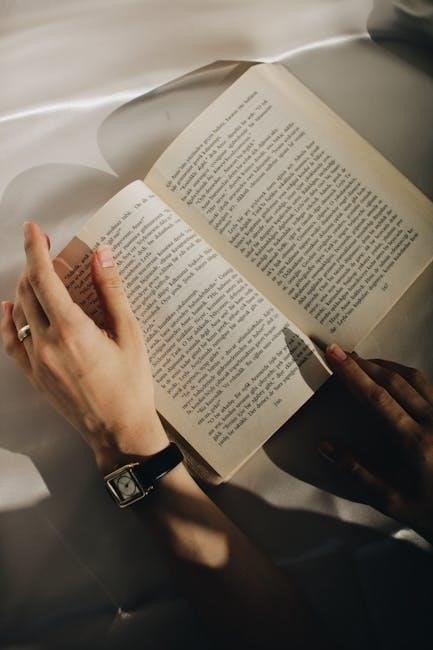nikon f4 instruction manual
Nikon F4 Instruction Manual: A Comprehensive Guide
Welcome to a comprehensive guide dedicated to the Nikon F4, a professional-grade film camera introduced in 1988. This guide will explore the camera’s features, operation, and resources, offering a thorough understanding for both new and experienced users.
The Nikon F4, a landmark camera launched in 1988, holds a special place in photographic history as a bridge between manual and autofocus systems. Celebrated for its robust build and versatility, the F4 is compatible with a wide range of Nikon lenses, including both manual focus and autofocus versions. This makes it a valuable tool for photographers who appreciate the tactile experience of film photography, while also benefiting from modern features. This guide will provide users with instruction to navigate its features, ensuring they can harness the full potential of this iconic camera.

Overview of the Nikon F4 Camera
The Nikon F4 stands as a pivotal model, blending manual precision with emerging autofocus technology. Its durable design and versatile lens compatibility make it a favorite among film photography enthusiasts.
Key Features of the Nikon F4
The Nikon F4 boasts a robust metal construction, ensuring durability in various shooting conditions. It supports both manual focus and autofocus lenses, providing flexibility for different photographic styles. Its advanced metering system allows for precise exposure control, crucial for film photography. The camera features multiple shooting modes, including aperture priority, shutter priority, and manual mode. The F4 also incorporates a bright viewfinder for clear composition and accurate focusing. Its ergonomic design enhances handling and ease of use. The camera’s compatibility with a wide range of Nikon accessories further expands its capabilities. The F4 remains a sought-after camera due to its blend of classic design and modern features, making it a valuable tool for photographers.
Nikon F4 Specifications
The Nikon F4, a 35mm SLR film camera, features a Nikon F mount, compatible with a vast range of lenses. It offers shutter speeds ranging from 30 seconds to 1/8000th of a second, plus bulb mode for long exposures. The camera uses a TTL metering system with various modes, including matrix, center-weighted, and spot metering. It has a built-in motor drive for continuous shooting. The viewfinder provides nearly 100% coverage for accurate framing. The F4 requires four AA batteries for operation or an optional rechargeable battery pack. Its dimensions are approximately 169 x 97.5 x 67.5 mm, and it weighs around 1090g without batteries or lens. The F4 supports DX-coded films and manual ISO setting.
Understanding the Nikon F4 Manual
The Nikon F4 manual is crucial for mastering the camera’s functions. Available in various languages, it provides detailed instructions on operation, settings, and troubleshooting, ensuring optimal use of this classic SLR.
Availability of Manuals in Different Languages
The Nikon F4, being a globally recognized camera, boasts manuals in several languages to cater to its diverse user base. English is commonly available, but finding manuals in languages like French (“Mode D’Emploi”), Spanish (“Manual de Instrucciones”), German (“Bedienungsanleitung”), and even Finnish (“käyttöopas”) and Japanese (“取扱説明書”) is possible. These manuals are invaluable for users who prefer instructions in their native tongue. Availability can vary, with some languages easier to find than others, reflecting the camera’s distribution and popularity in different regions. Online archives and communities may offer scanned or digital versions of these manuals.
Navigating the PDF Manual
When accessing the Nikon F4 manual in PDF format, efficient navigation is key. Most PDF readers offer features like bookmarks, which allow direct access to specific sections like lens mounting or film loading. Utilize the search function (Ctrl+F or Command+F) to quickly locate information on particular features or settings. Pay attention to the table of contents, if available, for a structured overview of the manual’s contents. Zoom controls enhance readability, and consider using annotation tools to highlight important notes or frequently referenced sections. Familiarizing yourself with these tools will greatly improve your experience.
Operating the Nikon F4
This section guides you through the fundamental operations of the Nikon F4. Learn how to mount lenses, load film correctly, set essential functions, and choose appropriate shooting modes for various photographic situations.
Mounting Lenses on the Nikon F4
Attaching lenses to the Nikon F4 is a straightforward process. First, ensure both the camera and lens mounts are clean. Align the lens’s mounting index (usually a dot or line) with the corresponding mark on the camera body. Gently insert the lens into the mount and rotate it clockwise until it clicks into place. A secure connection is crucial for proper exposure metering and autofocus operation, if applicable. To remove a lens, press the lens release button on the camera body and rotate the lens counterclockwise until it disengages. Always support the lens while mounting or unmounting to prevent accidental drops and potential damage to either the lens or the camera’s lens mount.
Loading Film into the Nikon F4
Loading film into the Nikon F4 requires careful attention to ensure proper advancement and prevent light leaks. Begin by opening the camera back, typically with a latch or lever. Insert the film cartridge into the film chamber, ensuring it sits securely. Pull the film leader across the film plane and attach it to the take-up spool. Advance the film using the camera’s film advance lever or motor drive until the film is properly engaged with the spool’s teeth. Close the camera back and continue advancing the film until the frame counter reaches ‘1’. This ensures any exposed film from loading is moved past the first frame. The F4’s motor drive simplifies this process.
Setting Functions and Shooting Modes
The Nikon F4 offers a range of shooting modes to cater to various photographic needs. To set a shooting mode, locate the mode dial, usually found on the camera’s top panel. Common modes include Program (P), Aperture Priority (A), Shutter Priority (S), and Manual (M). In Program mode, the camera automatically selects both aperture and shutter speed. Aperture Priority allows you to set the aperture, while the camera chooses the shutter speed. Shutter Priority lets you select the shutter speed, with the camera setting the aperture. Manual mode provides full control over both aperture and shutter speed. Other functions, such as exposure compensation and ISO settings, can be adjusted via dials and buttons.

Advanced Features and Settings
Explore the Nikon F4’s advanced capabilities, unlocking its full potential. Dive into features like manual focus lens compatibility, depth of field preview, and exposure memory lock to elevate your photography skills.
Using Manual and Autofocus Lenses
The Nikon F4 distinguishes itself with its ability to seamlessly integrate both manual focus and autofocus lenses. This compatibility offers photographers exceptional versatility. For manual lenses, the F4 provides metering capabilities, enabling precise exposure control. To utilize autofocus lenses, ensure the camera body is set to autofocus mode. The F4’s advanced focusing system then engages, providing rapid and accurate focusing. Be sure to consult the instruction manual for specific lens compatibility notes and optimal settings. Understanding the nuances of each lens type is key to maximizing the F4’s potential and achieving desired results, regardless of the focusing method employed.
Depth of Field Preview and Exposure Memory Lock
The Nikon F4 offers advanced features such as depth of field preview and exposure memory lock, enhancing creative control. Depth of field preview allows photographers to visually assess the zone of sharpness at a selected aperture before capturing the image. This is essential for critical focus applications. The exposure memory lock (AEL) function enables users to lock in a specific exposure setting, irrespective of changing light conditions. By pressing the AEL button, the metered exposure value is held, allowing for recomposing the shot while maintaining consistent brightness. Mastering these features allows for precise image control in challenging situations, boosting photographic expression.

Nikon F4S and F4E Variants
The Nikon F4 series includes the F4S and F4E variants, offering enhanced features. These models provide improvements like faster continuous shooting speeds and different battery configurations, catering to specific professional needs.
Differences and Similarities
The Nikon F4S and F4E variants share core functionalities with the original F4, maintaining compatibility with a wide range of Nikon lenses. Both offer advanced metering modes and robust build quality expected of professional cameras. Key similarities include the viewfinder system and film loading process.
However, the F4S distinguishes itself with a high-speed motor drive, enabling faster continuous shooting. The F4E, on the other hand, features a different battery configuration, often a larger battery pack for extended use. These subtle yet significant differences cater to photographers with specific requirements for speed and power.

Maintenance and Troubleshooting
Maintaining your Nikon F4 ensures longevity and optimal performance. This section covers essential cleaning, basic troubleshooting tips, and resources for addressing common issues, helping keep your camera in excellent working condition.
Basic Care and Cleaning
Proper care and cleaning are crucial for maintaining the functionality and extending the life of your Nikon F4. Regularly inspect the camera body for dust and debris, especially around the lens mount and film compartment. Use a soft, dry cloth to gently wipe the exterior surfaces, avoiding harsh chemicals or abrasive materials that could damage the finish.
For the lens, utilize a lens brush or air blower to remove loose particles before carefully cleaning with a lens cleaning solution and microfiber cloth. Store your F4 in a dry, dust-free environment when not in use, and consider using a camera bag for added protection during transport. By following these basic steps, you can ensure your Nikon F4 remains in optimal condition for years to come.
Resources for Nikon F4 Users
Explore valuable resources for Nikon F4 users, including online communities, forums, and downloadable manuals. These resources offer support, information, and guidance for operating and maintaining your camera effectively.
Online Communities and Forums
Engage with fellow Nikon F4 enthusiasts in online communities and forums. These platforms provide a space to share experiences, ask questions, and learn from other users. Discuss techniques for using manual and autofocus lenses, and also troubleshooting tips. Find advice on maintaining your F4 and explore advanced settings together. Share your photographs and receive constructive feedback from a supportive community. Benefit from collective knowledge and discover hidden features of this iconic camera. Participating in online communities enhances your understanding and appreciation for the Nikon F4’s capabilities, fostering a collaborative learning environment for all users. Connect, learn, and grow with fellow F4 aficionados.
Downloading Nikon User Manuals
Access official Nikon resources to download user manuals for various Nikon cameras, including the F4. These manuals provide detailed instructions and specifications for optimal camera operation and maintenance.
Official Nikon Resources
Nikon provides several official resources for users seeking information about their cameras, including the Nikon F4. These resources typically include downloadable user manuals, reference guides, and firmware updates. Nikon’s official website is the primary source for these materials, ensuring that users receive accurate and up-to-date information.
Furthermore, Nikon sometimes offers support documentation through its customer service portals. These portals may include FAQs, troubleshooting guides, and contact information for direct assistance. Utilizing official Nikon resources is the best way to ensure proper camera operation and maintenance, as well as to resolve any technical issues effectively. Always prioritize these sources for reliable guidance.





